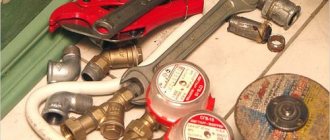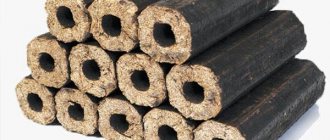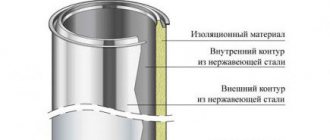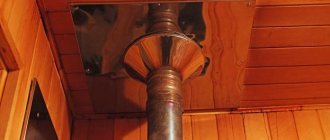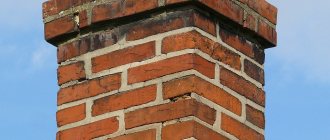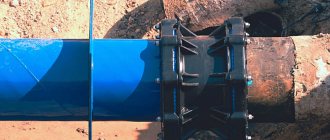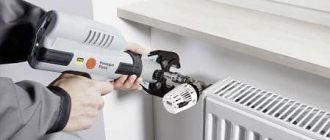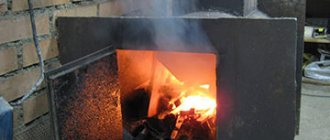A Russian stove, with crackling firewood inside, is a symbol of good family traditions and comfort. Masters of their craft passed on the art of laying brick chimneys to new generations. Modern building materials and technologies make it possible to install chimneys that can resist corrosion. So, for example, when it becomes necessary to replace the upper part of the chimney structure, a transition is made from a brick pipe to a sandwich.
Switching from a brick duct to a metal one may be necessary when installing a new chimney or when repairing an old one
Advantages and disadvantages of sandwich pipes for chimneys
It is difficult to unequivocally answer the question which pipe is better - a sandwich or a brick one. The correct choice is determined by many factors.
Firstly, the weight of the finished structure is of no small importance. Having found the necessary data in reference books and done simple arithmetic calculations, you can get a very interesting figure: a brick pipe is more than 30 times heavier than a sandwich pipe. Of course, with the same height and diameter of the toxic gas removal system.
Secondly, there is the issue of design reliability. Any movement of a wooden structure or the foundation of a house made of another more durable building material can lead, at worst, to a broken pipe, and at best, to its cracking.
And, thirdly, in terms of complexity, as well as in terms of work time, the process of building a brick pipe is much more labor-intensive.
But there is a factor that deserves special mention. It concerns the aesthetic perception of a country cottage. For many homeowners, the question of which - a brick pipe or a sandwich - to give preference to is not relevant: according to tradition, they choose the first option. But it can be realized only if the strength of the structure is guaranteed, and if the furnace stands on a strong foundation.
In general, developers highlight the following advantages of sandwich pipes for removing combustion products:
- small size;
- the ability to quickly and easily install a chimney without involving stove specialists;
- versatility of application. The product can be installed through walls or roofs;
- the presence of several layers prevents the creation of soot deposits and condensation;
- resistance to extreme conditions and aggressive environments (high temperature, chemicals, etc.).
Stainless steel chimneys are durable, do not require protective treatment and are suitable for almost all types of boilers and furnaces
Among the disadvantages it is worth noting:
- high price;
- service life, as practice shows, is limited to 15 years;
- the possibility of reducing the tightness of the chimney system.
These products can be used in houses made of any building material, but more often it becomes necessary to install a sandwich pipe on a brick pipe.
To make the transition to a sandwich pipe from a brick pipe, several methods are used.
- Implementation of this task using special square nozzles attached to a brick pipe.
- You can buy an adapter from a single-circuit design to a dual-circuit design. A wide platform is installed on the brickwork. The single-circuit design is directed downwards.
Advice! Fill the gaps formed during installation with non-combustible material.
Installation using a factory blank
The sandwich chimney is mounted on a special cylindrical adapter with a rectangular base. This blank is installed on a brick pipe to ensure the tightness of the structure. The butt joint is made from fire-resistant stainless steel. To prevent moisture accumulation, heat-resistant basalt insulation is installed inside the adapter. Installation of a butt blank consists of the following steps:
- Mount one adapter on the ceiling above the chimney masonry.
- Attach the second element to the attic floor.
- Build an installation platform and secure clamps if you need to switch from a square section to a round one.
- Install pipes. Building codes allow a slight immersion of the sandwich blank inside a brick pipe.
- Seal the seams with sealing mortar.
Features of performing a transition with a special adapter
It is recommended to purchase such adapters only in specialized building materials stores. Although the price there is higher than on the market, it will be more reliable in terms of product quality. Branded adapters have the following advantages:
- are made of heat- and acid-resistant high-quality stainless steel, as a result of which they are able to withstand short-term severe overheating without loss of durability;
- resistance to flue gases is minimized and the appearance of turbulence in their flow is eliminated due to a smooth transition to a brick pipe sandwich;
- the design allows you to reliably and easily seal joints;
- have an attractive appearance;
- Some models may offer different options. For example, turning the pipe at an angle of 45 degrees.
The adapter has a cylindrical shape on one side and a square shape on the other. Inside this element there is a layer of basalt wool. This is required by fire safety standards.
The joining of two pipes is carried out by a special adapter made of heat-resistant steel
The sequence of work steps for installing an adapter from a brick pipe to a sandwich pipe can be found below. In addition, there are certain nuances that you cannot do without.
- When installing, use two of these elements. Attach one of them to the floor of the attic, and the second to the ceiling directly above the brick chimney.
- Installation of a sandwich chimney must be carried out in compliance with building codes. The inner surface of a two-layer pipe must be no less than 38 centimeters away from combustible structures. Fill this space completely with non-flammable material.
- Sometimes a part of a steel channel is run inside a brick channel.
- To seal the seams during installation, you will need sealants. They will be required, and if smoke is allowed to pass through, not only the chimney, but also the stove itself. The material used to seal cracks will prevent dust and combustion products from entering the room even through minor cracks. The resistance of the sealant to high temperatures is guaranteed by the “Heat resistant” marking.
- When switching to a round section from a rectangular one, install the mounting platform, as well as clamps. The formation of protrusions in the structure and reduction of the cross-section are not allowed. Otherwise, there may be no traction, or, which is not better, it will act in the opposite direction.
How to assemble a chimney correctly?
Fire safety rules when installing a chimney require compliance with certain standards. To lay sandwich pipes through wooden structures, high-quality thermal insulation of metal parts from wooden (or any other flammable) parts is required.
In the case of a finished metal pipe, it is possible to purchase ready-made structures that insulate the roof from the effects of heat (pass-through unit) and precipitation (oblique lining and protective corrugated flange).
Rules for assembling a sandwich part of a chimney:
- The assembly of the structure is carried out from the bottom up.
- Metal parts are inserted into one another according to the principle of socket joints. The joints are sealed with a special non-flammable compound and reinforced with clamps (special clamps).
- There should be no joints in the section where the pipe is routed through the floors. This is a fundamental fire safety rule when assembling a chimney structure.
- If the roof is made of flammable material, it is necessary to install a spark arrestor on the head of the pipe. In any case, a protective cap is required.
- To secure the tall structure, I use tension cables.
General rules for installing a transition:
- The metal part of the pipe can be partially recessed into the brick part using the sleeve principle.
- It is unacceptable to reduce the internal part of the channel or install mechanical barriers (protrusions, fittings) for the passage of combustion products.
- To ensure tightness, use black oven sealant with resistance up to 1500 degrees. If the pipe is not going to be disassembled, then sealant is applied to the inside of the pipe. If the structure (in the future) needs to be disassembled, then only the outer seam is sealed. Later, during disassembly, the sealant is removed by mechanical force (broken).
- To switch from a square to a round cross-section, you definitely need a support platform (square) and a pipe (cylinder). It is better if it is a one-piece design.
We recommend that you read: Sound insulation methods to reduce noise in a sewer riser
There are several options for switching from a brick chimney to a sandwich pipe. Each of them has its own advantages.
How to install a sandwich pipe on a brick pipe without a factory adapter
It often happens that you simply won’t find an adapter from a brick pipe to a sandwich pipe on sale. It is possible to make a qualitative transition in this case as well. However, it will require a lot of time. To do this you have to perform the following steps:
- cut a round hole in the brick base. Its size should be approximately equal to half the thickness of the brick. And the diameter does not significantly exceed the value of this parameter of the internal part of the sandwich product;
- Place the inner part of the structure into the cut hole.
You can build an adapter with your own hands from the remains of any metal
Advice! Fill any gaps with pre-prepared oven mortar.
- The outer part of the structure is supported by a brick base. After installing one on top of the other, fill the joint with the same solution;
- At the next stage, the installation of the chimney system itself is carried out. To do this, insert all pipe components sequentially into each other and fix them;
- in the area where the chimney passes through the roof, secure the structure with cut-off metal profiles, screwing them with self-tapping screws. Carry out the entire operation of fixing the structure being created strictly in a plumb line.
How to put together a sandwich without a blank?
You can connect a pipe to a brick one without a ready-made adapter. There are several ways to lay a sealed joint. The joining of sandwich elements begins with preliminary work. The installation consists of the following steps:
- Select a method for connecting elements.
- Prepare construction tools and materials: grinder, hammer drill, metal plate, screws, dowels.
- Select a sealing solution for sealing joints.
- Make a hole of the required diameter in the attic floor.
- Disassemble the old chimney if a partial replacement of the chimney system is being carried out.
Connection using solution
This method of laying elements is relatively labor-intensive. To connect metal to a brick pipe, you need to carry out the following work:
- Fill the hole of such a size that the inner part of the sandwich pipe can be installed inside.
- Place the inner metal casing into the resulting hole.
- Shorten the outer layer of the steel chimney until it meets the brickwork.
- Seal the joints with sealing compound.
- Secure the structure with self-tapping screws at the point where the roof intersects.
Application of pipe and steel sheet
The use of a metal base to fix the sandwich pipe to the masonry contributes to a high level of tightness of the chimney system. To connect two pipes, you need to carry out the following work:
- Prepare a plate whose dimensions correspond to the measurements of the top edge.
- Place the workpiece against the bricks so that the edges do not rest on the seams.
- Mark the locations of the proposed holes.
- Drill through the masonry and plate at the designated points.
- Secure the dowels into the brick.
- Install the panel onto the sealing solution.
- Secure the plate with self-tapping screws.
- Install the air outlet elements of the sandwich structure.
Adjusting the dimensions of a brick pipe
This method is used to replace a deformed brick structure. After dismantling the old masonry, a smooth transition is made to a round sandwich pipe. The process of constructing a connection between two elements consists of the following stages:
- Disassemble the old chimney.
- Based on the previous design, build a new tapering structure. Such an extension should have a small height.
- After the solution has hardened, install the lower nozzle of the sandwich system into the narrow end of the structure.
- Fill with sealed cement mortar mixed with stones.
- Apply a layer of plaster to the surface of the narrowing.
We make the transition using a metal platform with a pipe
This method allows you to install a chimney without a special adapter.
Perform installation in the following sequence:
- cut out a platform from a metal plate. Its size must match the configuration of the brick part. Try to ensure that the plate does not protrude beyond its edges;
- mark the places where the platform is attached to the brick opening. Make sure that the fasteners are not located on the edges of the brick or on the seams;
- Drill holes for self-tapping screws in pre-designated places on the metal plate. Make holes in the brickwork, but for dowels;
- insert dowels into the holes made;
- Apply silicone fireproof sealant to the masonry surface;
- Place a metal platform on the sealant layer;
- using self-tapping screws, evenly tighten it with the brick surface;
- After letting the sealant dry, proceed to installing part of the chimney exhaust system from a sandwich pipe.
The adapter plate must be securely fastened to the brick base
By installing a homemade adapter with a pipe, you will speed up the installation of the chimney due to the fact that the pipes fit perfectly together through holes with widened and narrowed ends.
Step-by-step DIY connection technique
When deciding how to install a metal pipe with insulation with your own hands, the condition of the existing brick structure is assessed. If signs of destruction are visible, it is recommended to dismantle it. When you plan to install a metal product using the fitting method, it is necessary not only to dismantle the collapsing section of the chimney, but also to build a new structure afterwards.
Required tools and materials
To work you will need:
- perforator;
- chisel;
- sledgehammer;
- Circular Saw;
- fireproof mixture;
- sealant;
- screwdriver;
- self-tapping screws;
- Master OK.
Installation rules are followed, and components are selected taking into account the chosen mounting method.
Work progress
After dismantling the old structure, a new brick superstructure is erected on the roof. To fix the steel product in the ceiling, a through-type pipe is used. The transition of a brick pipe into a sandwich is made using a sealing material. In this case, a reinforcing platform is used, it is secured with self-tapping screws. Special clamps are used to connect sections of metal pipelines.
Installation features
When you plan to disassemble the chimney close to the stove, then in order to avoid overheating, a thick-walled stainless steel pipe should be used as the first link of the transition structure. There should be no insulation inside. Installing a sandwich pipe can lead to through burning of the metal.
To properly assemble the chimney, it is necessary to carry out the installation sequentially. During the completion of the work, a cap is installed on top of the metal pipe. However, the deflector causes a lot of controversy regarding the installation of this element on top of the sandwich pipe. This measure helps to increase traction. However, an earlier version of the regulatory documentation mentions a ban on the use of such products when installed on chimneys. This is due to a decrease in the pipe lumen and accelerated formation of a soot layer on structural elements.
Fitting a brick pipe
This is another method of creating a smooth transition from brick to round pipe. The essence of the technology is this:
- The old pipe is dismantled. On its remains, a gradually tapering short superstructure is erected using refractory bricks. It serves as an adapter. The narrowing is formed so that a special element of the chimney part made of a sandwich pipe can be installed on the superstructure. It is called the bottom nozzle or scientifically – mono-thermo transition. This product is a solid base on which a barrel assembled from pipe sections is installed. To reduce the external size of the brick part of the chimney, the brick is placed on the long end (spoon).
- The inner surface of the superstructure must be plastered - a smooth surface minimizes resistance to gas flow.
- The mono-thermo transition is installed on top of the brick superstructure. For tightness and stability, it is filled with a mixture of stones and cement mortar.
For brick chimneys, it is often necessary to dismantle only the outer part, since the masonry located in the house is, as a rule, in satisfactory condition. And this factor, due to the low weight and short length of the sandwich, allows its installation without a mono-thermal transition.
Advantages and disadvantages of such a connection
Switching to stainless steel sandwich pipes provides the following advantages:
- simpler and faster installation of a new chimney;
- you can install it yourself;
- less expensive;
- the design is lighter in weight, smaller in size;
- soot and other combustion products do not accumulate on smooth walls;
- the device can be brought out either through the roof or through the wall;
- the presence of an insulating layer, which to a certain extent reduces the amount of condensation;
- Possibility of installation through the rafter system.
The disadvantages of sandwich chimneys are the same as those of all modular smoke removal devices:
- over time, some loss of tightness at the joints;
- significant price of the kit and its installation;
- restrictions on service life (15-30 years).
Video: connecting a brick channel and a sandwich pipe
With prolonged use, even a good-quality brick pipe can become unusable, requiring replacement with a more modern option. Making an adapter from a brick pipe to a sandwich yourself is a labor-intensive process that requires certain skills. Therefore, it is better to order it from professional tinsmiths.
Did you like the article? Share it:
Making the right transition
Everyone knows that “sandwich” chimney pipes today are the most optimal and successful solution when the issue of smoke removal arises. Today we will tell you how to make the transition from a brick pipe to a metal one.
This work is quite serious, because exhaust gas removal is, first of all, about health, and if it is done incorrectly, then combustion and heat transfer will slow down. By also looking at the photos and videos in this article, you can get additional necessary information.
